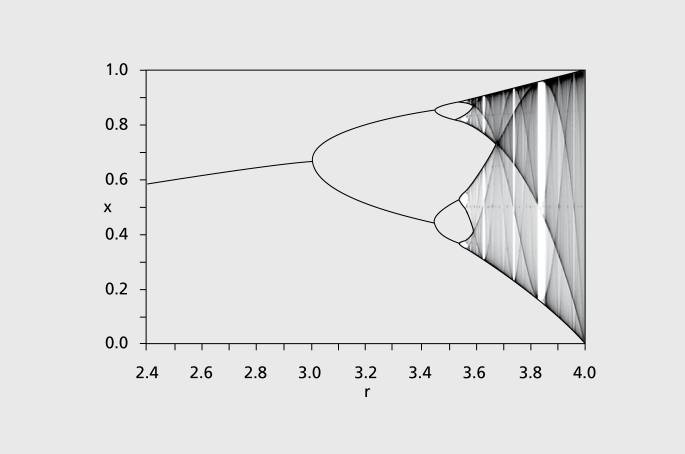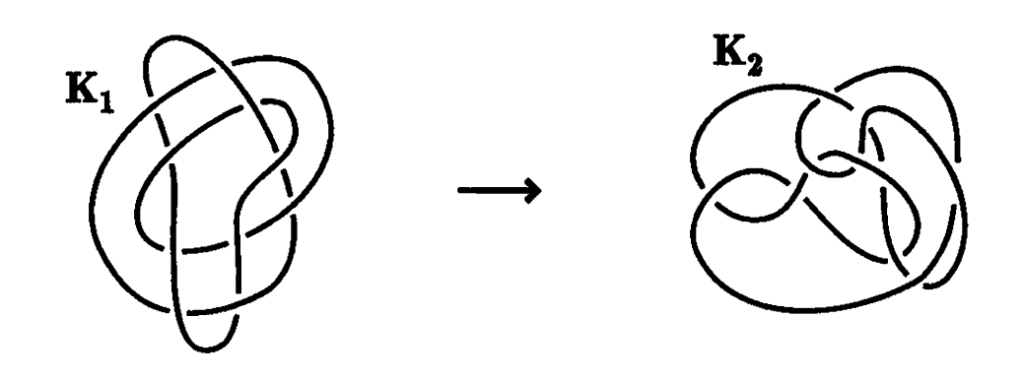CHAOS THEORY
Chaos theory is a branch of mathematics focusing on the study of chaos states of dynamical systems whose apparently random states of disorder and irregularities are often governed by deterministic laws that are highly sensitive to initial conditions. When employing mathematical theorems, one should remain careful about whether their hypotheses are valid within the frame of the questions considered. Among such hypotheses in the domain of dynamics, a central one is the continuity of time and space (that an infinity of points exists between two points). This hypothesis, for example, may be invalid In the cognitive neurosciences of perception, where a finite time threshold often needs to be considered.
Birth of the chaos theory
Poincaré and phase space
With the work of Laplace, the past and the future of the solar system could be calculated and the precision of this calculation depended on the capacity to know the initial conditions of the system, a real challenge for “geometricians,” as alluded to by d’Holbach and Le Verrier. Henri Poincaré developed another point of view, as follows: in order to study the evolution of a physical system over time, one has to construct a model based on a choice of laws of physics and to list the necessary and sufficient parameters that characterize the system (differential equations are often in the model). One can define the state of the system at a given moment, and the set of these system states is named phase space.
The phenomenon of sensitivity to initial conditions was discovered by Poincaré in his study of the the n-body problem, then by Jacques Hadamard using a mathematical model named geodesic flow, on a surface with a nonpositive curvature, called Hadamard’s billards. A century after Laplace, Poincaré indicated that randomness and determinism become somewhat compatible because of the long-erm unpredictability.
A very small cause, which eludes us, determines a considerable effect that we cannot fail to see, and so we say that this effect Is due to chance. If we knew exactly the laws of nature and the state of the universe at the initial moment, we could accurately predict the state of the same universe at a subsequent moment. But even If the natural laws no longer held any secrets for us, we could still only know the state approximately. If this enables us to predict the succeeding state to the same approximation, that is all we require, and we say that the phenomenon has been predicted, that It Is governed by laws. But this is not always so, and small differences in the initial conditions may generate very large differences in the final phenomena. A small error in the former will lead to an enormous error In the latter. Prediction then becomes impossible, and we have a random phenomenon.
This was the birth of chaos theory.


Lorenz and the butterfly effect Rebirth of chaos theory
Edward Lorenz, from the Massachusetts Institute of Technology (MIT) is the official discoverer of chaos theory. He first observed the phenomenon as early as 1961 and, as a matter of irony, he discovered by chance what would be called later the chaos theory, in 1963, while making calculations with uncontrolled approximations aiming at predicting the weather. The anecdote is of interest: making the same calculation rounding with 3-digit rather than 6-digit numbers did not provide the same solutions; indeed, in nonlinear systems, multiplications during iterative processes amplify differences in an exponential manner. By the way, this occurs when using computers, due to the limitation of these machines which truncate numbers, and therefore the accuracy of calculations.
Lorenz considered, as did many mathematicians of his time, that a small variation at the start of a calculation would Induce a small difference In the result, of the order of magnitude of the initial variation. This was obviously not the case, and all scientists are now familiar with this fact. In order to explain how important sensitivity the to initial conditions was, Philip Merilees, the meteorologist who organized the 1972 conference session where Lorenz presented his result, chose himself the title of Lorenz’s talk, a title that became famous: “Predictability: does the flap of a butterfly’s wing in Brazil set off a tornado in Texas?” This title has been cited and modified in many articles, as humorously reviewed by Nicolas Witkowski. Lorenz had rediscovered the chaotic behavior of a nonlinear system, that of the weather, but the term chaos theory was only later given to the phenomenon by the mathematician James A. Yorke, in 1975. Lorenz also gave a graphic description of his findings using his computer. The figure that appeared was his second discovery: the attractors.
The golden age of chaos theory
Felgenbaum and the logistic map
Mitchell Jay Feigenbaum proposed the scenario called period doubling to describe the transition between a regular dynamics and chaos. His proposal was based on the logistic map introduced by the biologist Robert M. May in 1976. While so far there have been no equations this text, I will make an exception to the rule of explaining physics without writing equations, and give here a rather simple example. The logistic map is a function of the segment [0,1] within itself defined by:
xn+1=rxn(1-xn)
where n = 0, 1, … describes the discrete time, the single dynamical variable, and 0≤r≤4 is a parameter. The dynamic of this function presents very different behaviors depending on the value of the parameter r:
For 0≤r≤3, the system has a fixed point attractor that becomes unstable when r=3.
Pour 3<r<3,57…, the function has a periodic orbit as attractor, of a period of 2n where n is an integer that tends towards infinity when r tends towards 3,57…
When r=3,57…, the function then has a Feigenbaum fractal attractor.
When over the value of r=4, the function goes out of the interval [0,1]


COURTESY- Christian Oestreicher, Department of Public Education, State of Geneva, Switzerland;* E-mail:hc.eg.ude@rehciertseo.naitsirhc
KNOT THEORY
In topology, knot theory is the study of mathematical knots. In mathematical language, a knot is an embedding of a circle in 3-dimensional Euclidean space, R3 (in topology, a circle isn’t bound to the classical geometric concept, but to all of its homeomorphisms). Two mathematical knots are equivalent if one can be transformed into the other via a deformation of R3 upon itself (known as an ambient isotopy); these transformations correspond to manipulations of a knotted string that do not involve cutting the string or passing the string through itself.
Although people have been making use of knots since the dawn of our existence, the actual mathematical study of knots is relatively young, closer to 100 years than 1000 years. In contrast, Euclidean geometry and number theory, which have been studied over a considerable number of years, germinated because of the cultural “pull” and the strong effect that calculations and computations generated. It is still quite common to see buildings with ornate knot or braid lattice-work. However, as a starting point for a study of the mathematics of a knot, we need to excoriate this aesthetic layer and concentrate on the shape of the knot. Knot theory, in essence, is the study of the geometrical aspects of these shapes. Not only has knot theory developed and grown over the years in its own right, but also the actual mathematics of knot theory has been shown to have applications in various branches of the sciences, for example, physics, molecular biology, chemistry.
FUNDAMENTAL CONCEPTS OF KNOT THEORY
A knot, succinctly, is an entwined circle. However, throughout this book we shall think of a knot as an entwined polygon in 3-dimensional space. The reason for this is that it allows us, with recourse to combinatorial topology, 1 to exclude wild knots. Close to the point P, in a sense we may take this to be a “limit” point, the knot starts to cluster together in a concertina fashion. Therefore, in the vicinity of such a point particular care needs to be taken with the nature of the knots. We shall not in this exposition apply or work within the constraints of such (wild) knots. In fact, since wild knots axe not that common, this will be the only reference to these kind of knots. Therefore, in order to avoid the above peculiarity, we shall assume, without exception, everything that follows is considered from the standpoint of combinatorial topology. As mentioned in the preface, our intention is to avoid as ,much as possible mathematical argot and to concentrate on the substance and application of knot theory. Infrequently, as above, it will be necessary, in order to underpin an assumption, to introduce such a piece of mathematical argot. Again, as mentioned in the preface, knowledge of such concepts will not usually be required to be able to understand what follows.


Definition. On a given knot K we may perform the following four operations.
(1) We may divide an edge, AB, in space of K into two edges, AC, CB, by placing a point C on the edge AB.
(1)’ [The converse of (1)] If AC and CB are two adjacent edges of K such that if C is erased AB becomes a straight line, then we may remove the point C.
(2) Suppose C is a point in space that does not lie on K. If the triangle ABC, formed by AB and C, does not intersect K, with the exception of the edge AB, then we may remove AB and add the two edges AC and CB.
(2)’ [The converse of (2)] If there exists in space a triangle ABC that contains two adjacent edges AC and CB of K, and this triangle does not intersect K, except at the edges AC and CB, then we may delete the two edges AC, CB and add the edge AB.




These four operations (1), (1)’, (2) and (2)’ are called the elementary knot moves.
A knot is not perceptively changed if we apply only one elementary knot move. However, if we repeat the process at different places, several times, then the resultant knot seems to be a completely different knot. For example, let us look at the two knots K1 and K2 which may be called Perko’s pair.


In appearance Perko’s pair of knots looks completely different. In fact, for the better part of 100 years, nobody thought otherwise. However, it is possible to change the knot K1 into the knot K2 by performing the elementary knot moves a significant number of times. This was only shown in 1970 by the American lawyer K.A. Perko. Knots that can be changed from one to the other by applying the elementary knot move are said to be equivalent or equal. Therefore, the two knots are equivalent.
Processing…Success! You're on the list.Whoops! There was an error and we couldn't process your subscription. Please reload the page and try again.











